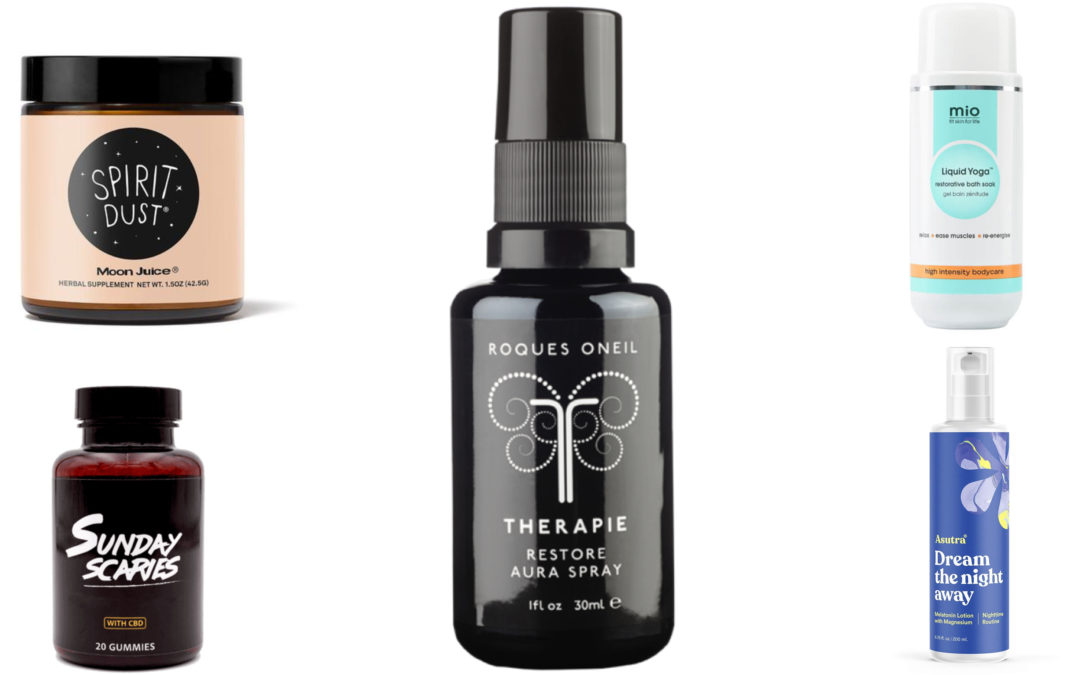
by Rebecca Taras | May 29, 2019 | Beauty, Beauty Products, Beauty Tips, Cosmetics, Health and Wellness, Rebecca's stories, Skin Care, Skincare, Travel
Traveling can be described as either life-changing or as a complete nightmare. No matter how much effort you put into planning the perfect vacation, you can’t account for flight delays (or cancelations), lost baggage, turbulence, theft, or any other hellish circumstance that makes you want to head back home so you can crawl into bed and pull the covers over your face. While many travel-related hiccups are beyond your control, you can try to get a hold of your stress and anxiety levels. With that in mind, here are five products to add to your packing list. They may not solve all your problems, but at least you’ll have a better mindset so you can make the most of your trip.
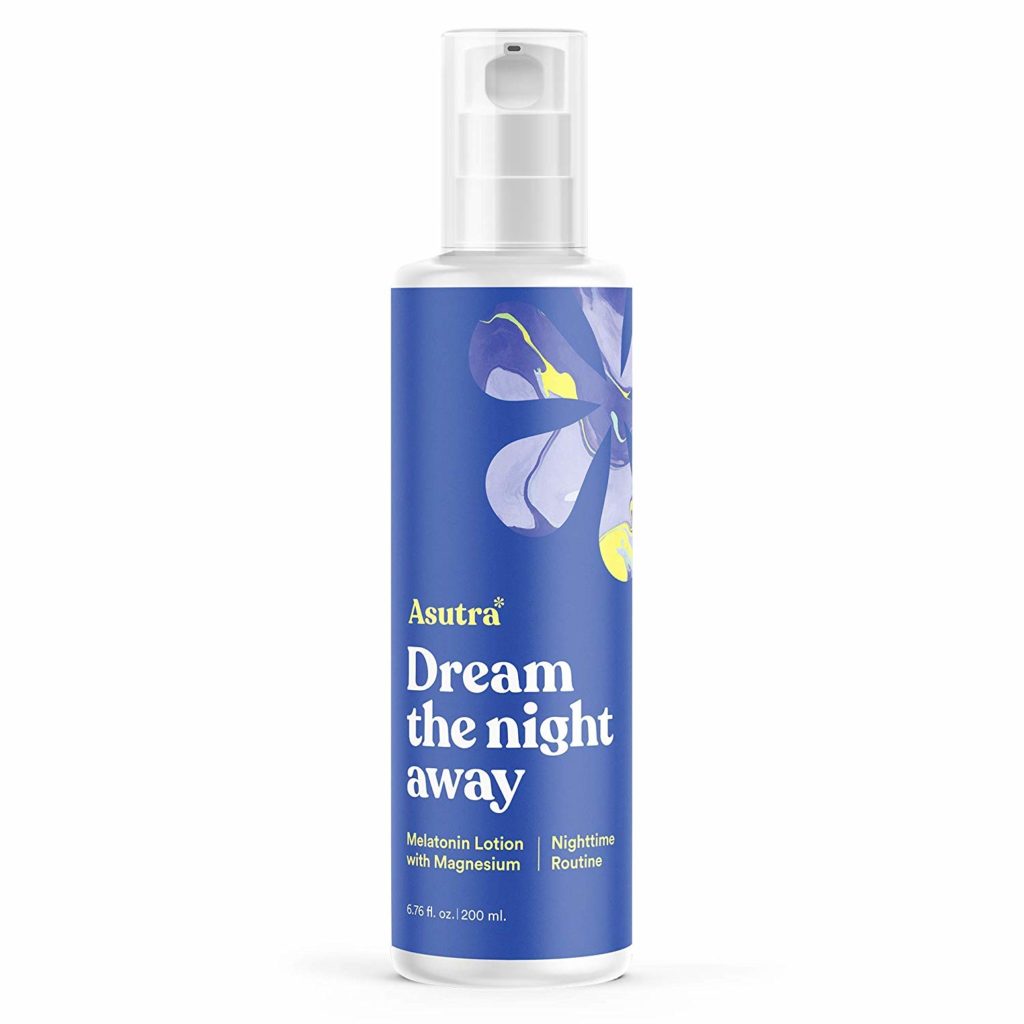
Photo courtesy of Asutra
Whether you’re staying in a budget bedroom or posh pad, it can be difficult to get decent shuteye in a new environment—especially if your jetlagged. Forget pillow spray. This product penetrates skin deep faster than you can count sheep. I first tried this lotion on an overnight flight from Chicago to Paris and I was impressed by how it helped me fall into a peaceful slumber despite being shoehorned in my coach seat. Bonus points for the lavender and lemongrass scent that eliminated the lingering aroma of the beef stroganoff that was served for dinner. But it’s not just the essential oils that induce sleep. This powerful lotion is packed with transdermal melatonin to aid sleep, magnesium to reduce pain/sore muscles, and a trademarked ingredient called OptiMSM to aid in magnesium absorption. It’s all topped off with hypoallergenic almond oil and shea butter to hydrate even the most sensitive of skin types. For best results, you’re going to want to apply the lotion (approximately 5 ml) 30 minutes before sleeping, two hours before if you have problems getting to bed early—or can’t turn off the in-flight entertainment.
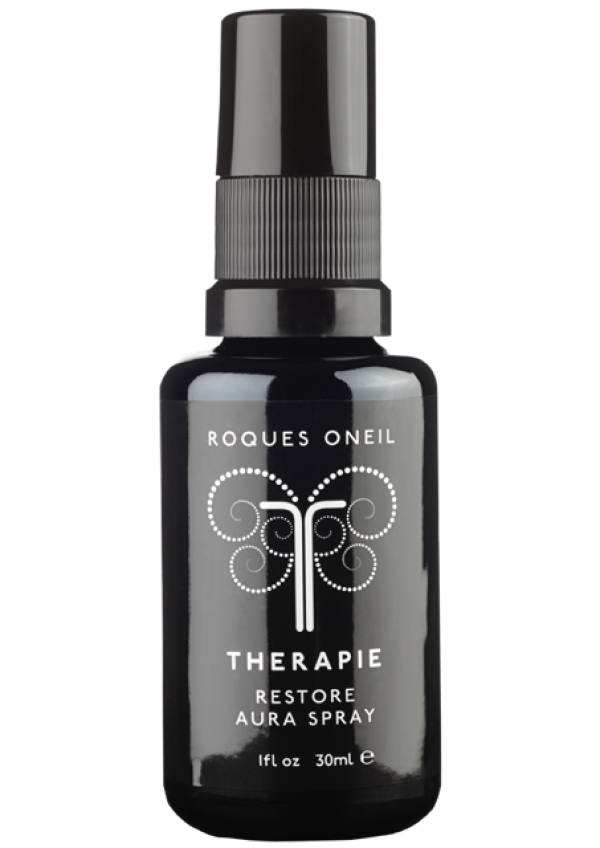
Photo courtesy of Roques O’Neil Therapie
Be it a ranting seatmate, your overly tired (read: crabby) kids, or the snooty waiter who won’t be bothered by your dietary restrictions, dealing with people (even those you love dearly) can be one of the most taxing aspects of a vacation. If you feel like you’re about to lose it, spritz a little Aura spray around yourself and take a long, deep breath. The combination of rosemary, fragonia, and rosewater will help you exchange negative energy, stress, exhaustion, tension, and sadness with clarity, balance, calm, and optimism. I don’t know about you, but I need this even when I’m not traveling—thank goodness it comes in a larger size.

Photo courtesy of Moon Juice
Drink your way into a stress-free vacation sans booze with this healthy concoction of reishi, ashwagandha, astragalus, mimosa bark, dan shen, longan berry, and goji. I know what you’re thinking: A margarita sounds so much more appealing, but trust me when I say this “dust” tastes better than it sounds—especially considering you’re only mixing 1 teaspoon into your coffee, milk, smoothie, or other favorite beverage. Note this product has progressive results, so start scooping the powder into your drinks five days before traveling in an effort to feel calm, balanced, and upbeat. I love this product, but if that doesn’t mean anything, so does Gwyneth Paltrow.
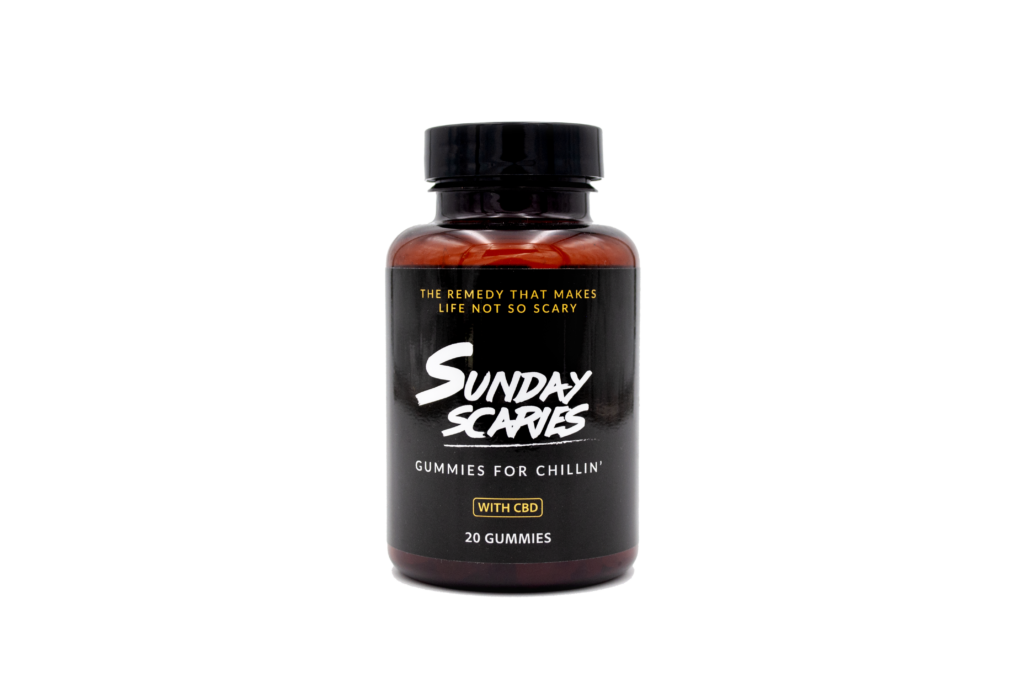
Photo courtesy of Sunday Scaries
CBD is all the rage right now, so I admit I was a bit skeptical about these cute little bears—especially after tasting how delicious they were! All of that skepticism went out the window 20-minutes later when the mood-enhancing benefits kicked in. While the name suggests this product will help you get rid of Sunday night anxiety before a new work week commences, I found that these gummies (legal and natural CBD anxiety relief with no THC) are perfect for helping me relax during a flight—especially an overnight jaunt—or if I get anxious about making a connecting flight. Honestly, they are likely to do the trick in any circumstance, but keep in mind that you’ll feel a bit sleepy, so heed my warning: Don’t chase these suckers down with one too many libations. The chews are also available in a vegan formula for those with dietary restrictions.

Photo courtesy of Mio Skincare
I admit that it was the name that encouraged me to purchase this product (I don’t even take baths at home!), however, I appreciate a good soak when I’m traveling because I’m more apt to relax and take my time. Not to mention, I love a good hotel room tub when available. This particular product is great if you’ve been on your feet sightseeing all day as the Epson salts, arnica, and Mio essential oil blend help relax both your muscles and your psyche at the same time. While it’s always a good idea to apply lotion, cream, or body butter after a soak, the addition of andiroba oil and murumuru butter will leave your smooth versus parched long after you’ve drained the water.

by Rebecca Taras | May 29, 2019 | Charming French Villages, Cote d'Azur, France, Historic, History, Luxury, Luxury Hotels, Perfume, Rebecca's stories, South of France, Travel
There’s no shortage of charming villages in France and while there are still many on my bucket list, I’ll never tire of Saint-Paul-de-Vence. Between the winding cobblestone streets, the remnants of some of the greatest artists and literary greats, and quaint restaurants with breathtaking views, Saint-Paul-de-Vence is worth venturing the short (and beautiful) drive on the winding roads if you’re visiting the South of France. Perched high on a hilltop, It just might arguably be one of the most beautiful villages in the Cote d’Azur…if not the entire country itself.
Fun Facts

Singer Line Renaud: © Office de Tourisme de Saint-Paul de Vence – Photographe: Jacques Gomot
—Originally known as Saint-Paul, the village acquired the name Saint-Paul-de-Vence because of its proximity to the commune of Vence. This was a smart idea as it differentiated this dream world from nine other French villages bearing the same name. The cognomen Saint-Paul-de-Vence became official in 2011.
—Saint-Paul was a border stronghold in the Middle Ages (1388) when the County of Nice switched its allegiance from Provence to the County of Savoy. It remained a border town until 1860 when Savoy was annexed to France.
—The village became more accessible in 1911 due to a newly erected tramway between Cagnes-sur-Mer and Vence, via Saint-Paul. Aside from attracting curious visitors, the new method of transportation also made it possible to export
—During the roaring ‘20s, Saint-Paul started to attract what we now know as some of the greatest artists in the world— Paul Signac, Chaïm Soutine, and Raoul Dufy were among the artisans at the forefront. Captivated by the rich array of colors and natural lighting, the tranquil village was their muse.
—While the Côte d’Azur has long been associated as a playground for the rich and famous, Saint-Paul-de-Vence was on their radar, too. The paradisiacal village has attracted the likes of an array of notable personalities, to include Ernest Hemingway, Zelda and F Scott Fitzgerald, Yves Montand, Simone Signoret, James Baldwin, Marc Chagall, Charlie Chaplin, Vittorio de Sica, Curt Jurgens, Orson Welles, Line Renaud, Liza Minnelli, Kirk Douglas, Gene Wilder, and Michael Caine, to name a few.
—When you’re walking on the beautiful Provencal-style cobblestone streets, take note that they were barren until the ‘50s when Mayor Marius Issert turned the streets into what you can see today. Also interesting, the very first cobbles were brought back from the beach at Cagnes sur Mer.
Where To Stay

Photo courtesy of La Mas De Pierre
La Colombe d’Or: One can’t discuss lodging options in Saint-Paul-de-Vence without suggesting this historic gem. Back in 1920, the property was known as a cafe and bar called Chez Robinson. In an effort to support his wife Baptistine (Titine), its proprietor—painter/art collector Paul Roux—made additions to the property so that it could facilitate a small three-room inn known as Colombe d’Or. At this time, it served as an artist’s playground for legends such as Picasso and Matisse. Their work, along with pieces from several other greats, still resides in the hotel today for your viewing pleasure. Over the years, the property became a sought-after retreat for celebrities and A-listers alike. Luckily, the Colombe d’Or of today can accommodate more guests—it boasts 13 rooms and 12 suites to be exact. You’ll find modern-day conveniences such as dry cleaning and room service. Speaking of food, even if you’re not a guest, you’re going to want to eat at the on-site restaurant. The menu features quintessential Provencal-style dishes such as stuffed baby vegetables, baked Provençal tomatoes, and a variety of fresh fish and meat dishes. If you visit in the warm weather months, you’ll be treated to the secret garden-like outdoor terrace. As of the this post, room rates range between 250 and 430 euros per night depending on room selection and season.
Le Saint Paul: Also conveniently located within the village, this five star property (a previous residence from the 16th century) possesses 16 rooms and terrace suites with sweeping views of the Medieval village and area surroundings. Take a meal out on the sprawling terrace where you can choose from menu items that correspond with the season. It’s worth taking an extra cup of coffee (or glass of wine) to soak up the awe-inspiring environs the French way—by taking your time. As of this post, room rates range between 250 and 630 euros per night depending on room selection and season.
Le Mas de Pierre: I had the pleasure of recently staying at this Eden and let’s just say that I didn’t want to leave! Le Mas de Pierre is a five-star boutique hotel (Relais and Chateaux) that’s located just on the outskirts of town. A mas, to be clear, is defined as a Provençal-style farmhouse, which is exactly what this place feels like on an elevated level. The property is surrounded by spectacular landscape that includes commanding mountains; centuries-old olive trees; and aromatic fig, orange, and lemon trees that dot the hotel grounds. As there are less than 60 rooms (cleverly divided amongst several buildings for the utmost in privacy), the feeling here is more like staying at a private estate than a big hotel. The service is impeccable, the decor is on-point, and I love that every room has a private (and generous) balcony or garden. Flying doves (literally) make their way around the grounds, on-site herb and vegetable gardens provide inspiration for the chef, you can visit the hotel owner’s birds in the exotic garden, and the last greenhouse in this historic area of greenhouses is used to cultivate all the orchids and plants in and out of the hotel. As of this post, room rates range between 215 and 1848 euros per night depending on room selection and season.
Where To Eat

Le Tilleul: Photographed by Rebecca Taras
Le Tilleul: Not only is this charming eatery perfectly positioned for people watching and immersing yourself in village life, the food is fantastic. The seasonally changing menu is gastronomic, yet comfortable—you can even find a simple sandwich on the lunch carte if you aren’t in the mood for a feast, but still want to enjoy the views. When I visited with my boyfriend, it was a crisp fall day, but blankets were available at all of the chairs. We used ours (and a bottle of red wine) to keep warm. Along with the complimentary olive tapenade, we shared two of the starters of the day: shrimp with avocado cream (artfully nestled in a small, clear glass) and cured salmon gravlax, which was served with a mini salad lightly tossed in a zesty citrus dressing. For the mains, my S.O. had a filet with nicoise olive mashed potatoes and I opted for the linguini con le vongole—aka linguini with clam sauce. Even though we cleaned each and every plate, we still managed to save room for one of the house-made desserts: a berry coulis and cream trifle.
La Brouette: While this restaurant is not exactly French, the Danish cuisine is as delectable as the owners (and hosts) are charming and hospitable—it wouldn’t be around for 40-plus years otherwise! Specialties include Baltic herring, house-marinated and smoked salmon, smoked trout, and a selection of Danish desserts. During the warm weather months, make a reservation for the rustic, lush patio where you can catch the fireworks on selected nights during the summer. When the chill hits the air, the inside is just as cozy, thanks to a warm burning fireplace.
(See above for information on the restaurant at Colombe d’Or.)
Where To Shop
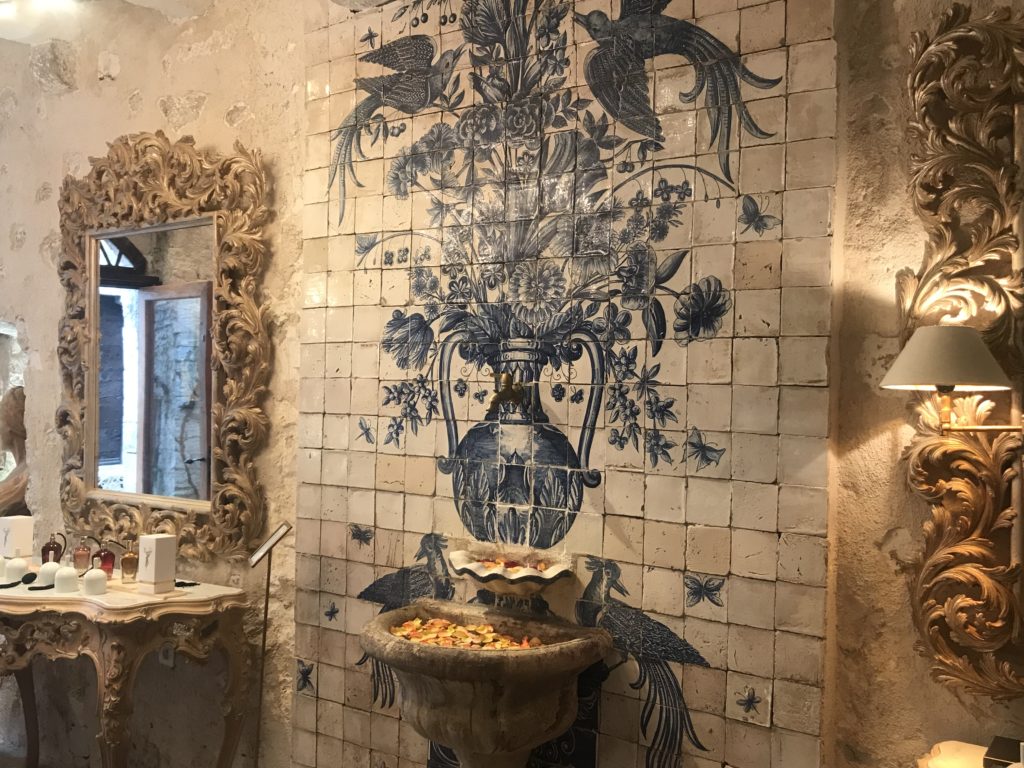
La Maison Godet: Photographed by Rebecca Taras
Galerie Frédéric Gollong: This illustrious gallery one of the first art spaces to open in Saint-Paul de Vence. Along with works from historic greats such as Matisse, Picasso, Valodon, Alechinsky, Braque, and Miró, you’ll also find more contemporary pieces from Van Velde, Wimmer, Berthois-Rigal, and Coignard, to name a few.
Galerie Le Capricorne: A diverse gallery that features a wide array of classic and contemporary works in various styles, to include landscapes, street art, abstract, pop art, and illustrations. You’ll find stunning pieces from great masters like Picasso, Chagall, Matisse, and Braque, as well as contemporary creations from artisans such as Michel Dejos, Isabelle Plante, Sylvia Karle-Marquet, Claude Fauchere, and Christophe Gallard, among several others.
La Maison Godet Parfum: A personal favorite, this perfume house dates back to 1901, and has since then whipped up umpteen fragrances that pay homage to everything from cognac (the family’s first business) to the muses of some of the greatest artists milling around Saint-Paul-de-Vence back in the day. All fragrances are made locally and it’s not uncommon that they contain ingredients found right in the village—like figs from the tree at Colombe d’Or. The current “nose” is the great granddaughter (Sonia) of founder Julien-Joseph Godet. If you’re lucky enough, she’ll be in the shop the day you visit; brace yourself for a real treat.
La Petite Cave de Saint Paul: Housed in a 14th century wine cellar, this cavernous shop offers an array of wines from the region of Provence. Wine and spirit aficionados will appreciate the well-curated selection of Cognac, Calvados, Armagnac, champagne, Bordeaux Grands Crus, and some of the best bottles from Burgundy and the Rhone Valley.
Where To Visit

Cimetiere de Saint-Paul-De-Vence: Photographed by Rebecca Taras
Fondation Maeght: Going on 50-plus years, the Fondation Maeght features the largest and most influential collections of 20th century art in all of Europe.
Musée de Saint-Paul: Take a deeper dive into the artistic history of Saint-Paul by visiting this well-appointed museum that’s housed in a stone house from the 16th century. Exhibitions change regularly and typically feature the works of artists whose works are associated with the village.
Cimetière de Saint-Paul-De-Vence: Dating back to the 16th century, this quaint cimetière is the resting place of famous locals such as Chagall (known for his paintings of the area) and Marguerite et Aimé Maeght, art gallery owners and dealers who lost their son Bernard at the age of 11—he is also buried here. Fondation Maeght became their project to get through this tragedy.
Jacques Prévert’s House: Ask a local to point you in the direction of French poet and screenwriter Jacques Prévert’s house, an unapologetically charming stone abode where he lived with his wife his wife Janine. Prévert was friends with Pablo Picasso and Paul Roux, owner of the Colombe d’Or.
Place de la Grande Fontaine: A vaulted washhouse serves as a memory for the old town square. Today, it’s a spot for locals to sell farm fresh produce.
Planning Your Trip
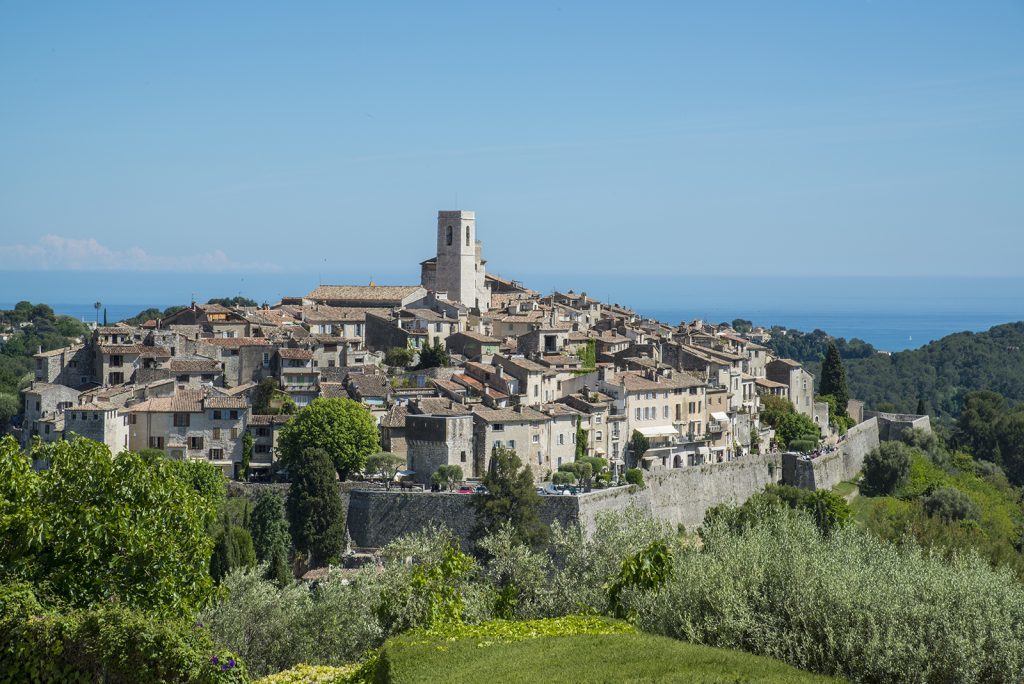
Le Village de St.-Paul-de-Vence
© Office de Tourisme de Saint-Paul de Vence – Photographe: Elisabeth Rossolin
By no means are my suggestions a complete list of what you can eat, do, and, see in Saint-Paul-de-Vence, but they are definitely both personal and popular favorites. Don’t be afraid to visit in the off-season as summer can be overwhelmingly crowded, which makes it difficult to book a table at a restaurant, a room at a hotel, or to full enjoy the shops and sites. Have you ever visited this charming French village? What are your favorite places?
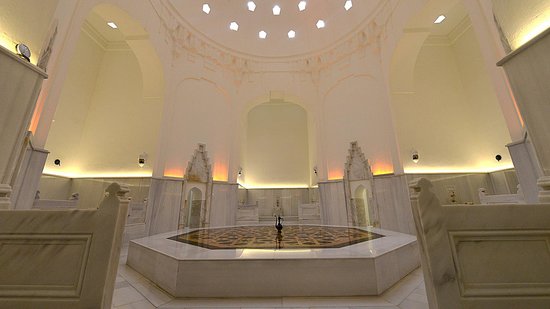
by Rebecca Taras | Feb 27, 2019 | Beauty, Hamam, Istanbul, Rebecca's stories, Spa Resorts, Spa Retreats, Spa Treatments, Spas, Travel, Traveling with Style, Turkey
If you’ve ever been to a fancy hotel or destination spa, then you’ve probably experienced some sort of treatment incorporating traditions and ingredients from a faraway land. Whether it was a Thai massage, Chinese acupressure, or an Indian Shirodhara ritual, it probably wasn’t too hard to feel temporarily transported to another destination—even if just for an hour. While I’ll never stop my endless quest for finding the most authentic and results-driven global services that delight the senses as well as the mind, I was almost about to call off the dogs after my recent experience at an authentic Turkish hammam (a.k.a. hamam) in Istanbul.
Dating back to 1556, the Ayasofya Hurrem Sultan Hamam (located between the Hagia Sophia and Blue Mosque) is one of Istanbul’s most stunning representations of the time-honored Turkish bath culture. The historical structure was designed and built by Mimar Sinan, the chief Ottoman architect, upon the requisition of Hurrem Sultan (Roxelana), the wife of Sultan Suleiman the Magnificent in the 16th century (1556-1557 AD). Its location is particularly significant, as it was erected where the ancient public baths of Zeuxippus (100-200 AD) used to stand, which also happens to be where the Temple of Zeus once stood.
The Ayasofya Hurrem Sultan Hamam was built in the classical period Ottoman bath style, yet it was an innovation in Turkish bath architecture because it was designed to have the sections for men and women constructed on the same axis as mirror images of each other. My journey began on a beautiful fall evening in Istanbul—which was much needed considering I had just completed a two train, plane and cab journey from Lake Como, Italy, starting at the ripe hour of 4:30 a.m.

There are a variety of individual services and packages to choose from, but having never experienced a hammam, I went for one of the more robust options, which only set me back about $100 for 90-minutes of bliss. Despite being there in off-season, note that you still have to make advanced reservations—though I only made mine the day before and was granted my preferred time slot.
From the moment I walked into the hammam, I knew I was in for something special. My first impressions were: It was as clean as a whistle, the architecture was even more drop-dead gorgeous in person than on the photos I saw online, it smelled like an exotic Garden of Eden, and the traditional Turkish music that was playing softly in the background was the perfect catalyst for transporting visitors into another time and place—including yours truly.
I was escorted to a small changing area where I was given disposable panties and a very small towel (the traditional bath wrap called a pestamal) to cover myself with—let’s just say that it didn’t quite cover everything. I was then taken to the main room of the bath house where all the magic happens. My therapist instructed me to drop my towel, which was a new experience for an American who has worked in spas where proper draping was non-negotiable. I quickly scanned the room and noticed that women of all shapes and sizes were sporting their birthday suits without any inhibitions, so I let that terrycloth hit the floor and got ready to hammam like a pro.
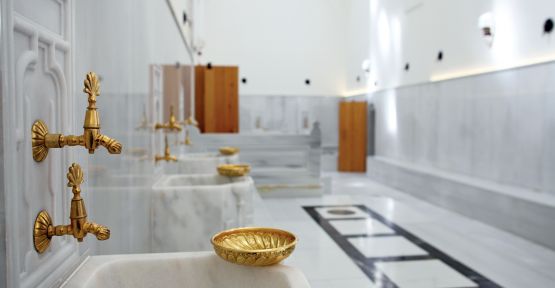
The therapist left me on a heated marble step near a gold faucet/marble basin, where I was instructed to ladle warm water over my hair and body with the use of a beautiful, gold-plated ottoman bath bowl. Next, we moved to the nucleus of the room—a heated, octagonal slab of marble—where I laid on my back while my therapist gave me a traditional body scrub and relaxing bubble wash scented with essential oil of Melissa, which smells very similar to lemongrass. After I turned over and the process was repeated, I moved to yet another “station” where my hair was washed and conditioned with Judas tree essential oil-infused products.
The next step left my skin as smooth as silk for days—even after showering a few times. My therapist slipped a traditional olive oil bar of soap (again, scented with Melissa E.O.) into a dampened bath glove and vigorously rubbed every extremity of my body in an effort to give my skin a thorough exfoliation. Next, I was rinsed and wrapped in a large towel and escorted to the main relaxation area, where I was served water, Turkish Delight and a local beverage called Ottoman sharbat, a cold beverage made from fruits, spices and flower petals.
After a few moments of of becoming entranced by the hypnotic music in my relaxed state, I was escorted up three flights of stairs to a private room for a Judas tree essential oil aromatherapy massage. The top floor rooms aren’t covered, so I was able to take in the glow of the dreamy blue light that filled the beautiful domed ceiling of the hammam itself.

My hammam tips and takeaways:
- Get over being body conscious. Trust me when I say nobody is looking at you, and an experience like this is more about wellness than vanity. Refreshing, right?
- Take the time to really soak in your surroundings. Chills ran down my spine when I thought of how many people enjoyed this amazing ritual in the exact same spot over the past 400-plus years.
- Go for one of the larger packages of services. You can receive a full hammam experience in less than it costs for one service at a traditional spa or resort; it’s completely worth it!
- You’re going to love how you feel and smell when you leave, so take note of how silky smooth your hair and skin feels afterwards. As mentioned earlier, I still felt the results even after taking several showers. What won’t last, however, is the delectable aroma of essential oils that envelops your hair and skin from top-to-bottom.
- Each guest receives their own “hammam kit,” which includes everything you need for your entire journey, so it’s extremely sanitary. You even get to take home body lotion, olive oil soap, your bath mitt and sandals. A perfect souvenir until you can make it back to paradise.

















